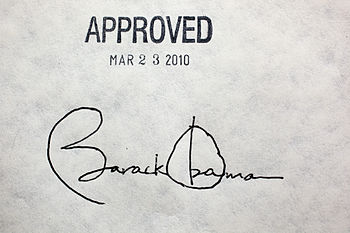By Rick Fromme
| President Barack Obama's signature on the health insurance reform bill at the White House, March 23, 2010. (Photo credit: Wikipedia) |
As I sit down to research and
write this blog, I see that, according to Google’s whimsical holiday-related
font, today is the first day of spring. Makes sense; it’s gorgeous here at
Ponte Vedra Beach, Florida. The advent of spring means several things are
imminent. For one, April; concomitantly, our 2013 tax returns.
And, for the
first time ever, millions of Americans have until March 31st* to sign up for 2014’s
open enrollment period for their new “marketplace insurance” as mandated by our
nation’s new health care reform.
* On Tuesday, March 25th, the White House announced it was extending the sign up deadline for the ACA for a few more weeks. Fom the "Los Angeles Times": The Obama administration plans to allow consumers to complete enrollment for health insurance under Obamacare after next week's deadline as long as they declare that they started the process before the end of the month.
The new law is officially known as “The Patient Protection and Affordable Care Act (PPACA) 2010 HR3590,” more commonly referred to as the “Affordable Care Act,” (ACA), as well as both affectionately and contentiously called ObamaCare. It’s made up of the “Affordable Health Care for America Act,” the “Patient Protection Act,” the health care-related sections of the “Health Care and Education Reconciliation Act,” and the “Student Aid and Fiscal Responsibility Act.” It also includes amendments to other laws such as the Food, Drug and Cosmetics Act and the Health and Public Services Act.
* On Tuesday, March 25th, the White House announced it was extending the sign up deadline for the ACA for a few more weeks. Fom the "Los Angeles Times": The Obama administration plans to allow consumers to complete enrollment for health insurance under Obamacare after next week's deadline as long as they declare that they started the process before the end of the month.
Officials said they were making the move now in anticipation of a last-minute rush of consumers seeking health insurance ahead of the March 31 deadline. On Monday, more than 1.1 million people visited HealthCare.gov, the second-largest traffic day on the site, the White House said.
The new law is officially known as “The Patient Protection and Affordable Care Act (PPACA) 2010 HR3590,” more commonly referred to as the “Affordable Care Act,” (ACA), as well as both affectionately and contentiously called ObamaCare. It’s made up of the “Affordable Health Care for America Act,” the “Patient Protection Act,” the health care-related sections of the “Health Care and Education Reconciliation Act,” and the “Student Aid and Fiscal Responsibility Act.” It also includes amendments to other laws such as the Food, Drug and Cosmetics Act and the Health and Public Services Act.
| Rubik's Cube variants from 2×2×2 all the way to 7×7×7. Inspired by Rubik's cube variations. (Photo credit: Wikipedia) |
Like many types of over-arching
legislation, ACA is long and complex as it attempts to reform America’s
multi-sided Rubik’s Cube of a health care system by providing more citizens
with affordable quality health
insurance and by curbing the growth in
U.S. health care spending. Ambitious goals, indeed. Reforms include new
benefits, rights and protections, rules for insurance companies, taxes, tax
breaks, funding, spending, the creation of committees, education, new job
creation and more. In many cases, ACA gives power to the ongoing efforts by
Health and Human Services and other federal programs seeking to reform health
care. So change doesn’t just happen with the ACA. For more information, visit
the Health and Human Services site for information on health care reform beyond
the ACA.
Simply stated, the ACA attempts
to ensure Americans are treated fairly in their right to receive affordable,
quality health care, as it strives to make health insurance more affordable to
lower and middle income Americans and small business employers. Realistically,
no one, even those who crafted and lobbied for ACA, sees it as a panacea, but
at least a hopeful step in the right direction.
Condition Critical
| Health care reform supporter at town hall meeting in West Hartford, CT, 2009-09-02 (Photo credit: Wikipedia) |
Why do we need health care
reform? From directly increasing
American’s personal debt and even bankruptcy, to the ever-increasing costs of
health care, to rising profits of many health care corporations, the U.S.’
health care system is in trouble. A system designed for profits will always do
what it can to consistently earn a profit. And therein lies some of its
maladies.
Just four years ago, investigations
and reports by such venerated organizations as the “Washington Post,” “Forbes,”
“Time,” and others strongly opined that our nation’s health care system was in critical
condition. Consider just some of their findings:
- In 2009, Americans spent approximately $2.8 trillion on health care, and it’s projected we’ll spend $4.5 trillion on health care by 2019.
- The U.S. spends more on health care than Japan, Germany, France, China, the U.K., Italy, Canada, Brazil, Spain and Australia — combined. Yet unlike many of these other countries, not every American has free or low-cost health insurance.
- According to a report by Health Care for America Now, America's five biggest for-profit health insurance companies ended 2009 with a combined profit of $12.2 billion. Similarly, the top executives at America’s five largest for-profit health insurance companies had combined salaries topping $200 million. Your ever-increasing costs ensure their profits increase.
- If the U.S. health care system was a country, it would be the sixth largest economy in the entire world.
- Back in 1960, an average of $147 was spent per person on health care per year; by 2009, that number had skyrocketed to $8,086.
- The 2009 study found approximately 62% of all personal bankruptcies in the U.S. were related to medical bills, even though a majority — 78% — had health insurance. These unfortunate citizens were bankrupted due to gaps in coverage like co-payments and deductibles and uncovered services. Others who had private insurance got so sick that they lost their jobs and consequently, their insurance.
- Price setting for health care services isn’t regulated by government. Prices are set by the private for-profit organizations such as AMA’s Specialty Society Relative Value Scale Update Committee.
- From 1998-2009, the U.S. health care industry had spent more than $5 billion dollars on lobbying our politicians in Washington D.C.
- The U.S. ambulance industry makes more money a year than the entire movie industry.
- Nearly half of all Americans use prescription drugs. More than 25 for-profit companies made over a billion dollars in profit from prescription drugs in 2008 alone. In 2013, over $280,000,000,000 was spent on prescription drugs.
- And here’s yet another: In the last 10 years, health insurance premiums have risen three times faster than wages.
I could go on, but I think you get the picture. By staying the course, the prognosis isn’t good.
ACA & Health Care Jobs
What is good, however, is that
because the ACA readily offers coverage to certain health conditions and
preventative testing that were not part of traditional coverage, certain
medical support staff positions will likely become more necessary once the law goes
into effect. In fact, the simple implementation of the
provisions of the ACA
within medical facilities and insurance companies will increase the need for
support staff. Because more Americans will be insured, many speculate the job
growth in most health care sectors will be robust. (See my previous blog,
“Health Care Jobs Outlook is Jammin’!”) Considering the current demand for many
health care positions, pundits forecast an increased need in certain health
care careers once ACA is implemented. Here are some health care jobs that will
be positively affected following the implementation of the ACA:
Medical Insurance Processing
Because submitting claims via the
guidelines of the ACA will require different methodologies from hospitals,
doctor’s offices and other medical facilities, medical insurance claim firms
should be adding additional processing staff. In addition, to prepare for the
onset of the ACA, additional staff will have to be retained in order to prepare
the facility’s systems to be in compliance with the requirements, filing
limits, and filing deadlines associated with the new health care plan.
Physical Therapists
| Physical Therapy Equipment (Photo credit: kbrookes) |
Diagnostic Technicians
In addition to increased rehab
care, the ACA provides increased preventative care and diagnostic services —
the goal being to catch maladies and diseases in their earlier stages when
they’re more treatable. So such procedures as mammograms, PSAs and other
screenings will be more accessible to those who didn’t previously have
coverage. Consequently, the number of diagnostic technicians across a broad
range of specialties (X-ray, ultrasound, laboratory work, etc.) is expected to
increase.
Dental Personnel
While the ACA doesn’t increase
dental benefits for adults, it does make dental care available for children,
hence the increase for dental assistants, hygienists, dental lab technologists
and dental billing/administrative personnel will be in demand. Let’s not forget
dentists; that profession was the number one fastest growing profession
according to “US News and World Report’s” findings (again, see the blog,
“Health Care Jobs Outlook is Jammin’!”).
In this article, I gave a brief
overview of the new health care legislation, the Affordable Care Act, which is
soon going to affect every American. I also mentioned some of the various
maladies and symptoms that are adversely affecting our for-profit health care
model. Lastly, I listed some of the health care specialties that are expected
to continue their upwards growth curve in particular due to the enactment of
the ACA. If you’d like to make a relevant comment about this article, please
post below. If you found this article informative and helpful please pass it
along.
* Resources: 1.
http://www.washingtonpost.com/blogs/wonkblog/wp/2013/03/26/21-graphs-that-show-americas-health-care-prices-are-ludicrous/
2. http://www.forbes.com/sites/danmunro/2013/02/11/healthcares-pricing-cabal/
3.
http://www.foxbusiness.com/on-air/willis-report/blog/2013/02/25/why-health-care-costs-are-so-out-control
4.
http://theeconomiccollapseblog.com/archives/50-signs-that-the-u-s-health-care-system-is-a-gigantic-money-making-scam-that-is-about-to-collapse
5. www.justfacts.com/healthcare.asp 6. healthcare.gov 7. TIME: Why Medical Bills
Are Killing Us 8.
http://www.cms.gov/Research-Statistics-Data-and-Systems/Statistics-Trends-and-Reports/NationalHealthExpendData/downloads/proj2009.pdf
Rick Fromme combines
entrepreneurial enthusiasm with an insider's knowledge of the medical industry
to co-found MedMasters.com. Both
his drive and perspective helps provide health care professionals with a
superior mechanism with which to communicate, network and market their
strengths. Prior to founding MedMasters.com, Rick operated a highly
successful medical device distributorship. Other milestones in his 12-year career
in the medical industry include a key position at a medical
device start-up company that was later sold to the Ethicon
Endo division of Johnson & Johnson. You may reach Rick
by connecting with him on Facebook, Twitter, Google+, LinkedIn and YouTube.
















In Washington the credo seems to be, "If it ain't broke, break it."
ReplyDeleteWhile I'm not totally pleased with the current state of the ACA, I think the US had to do something in the direction of health care reform. We're behind so many other industrialized countries in this regard.
ReplyDelete